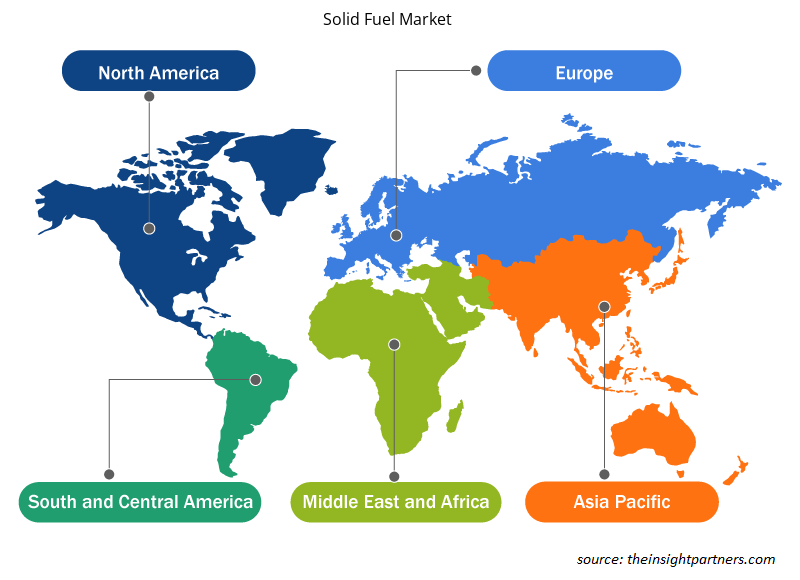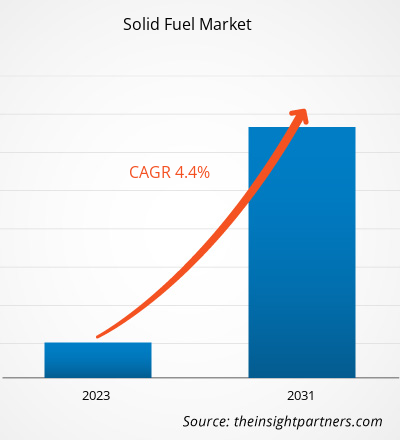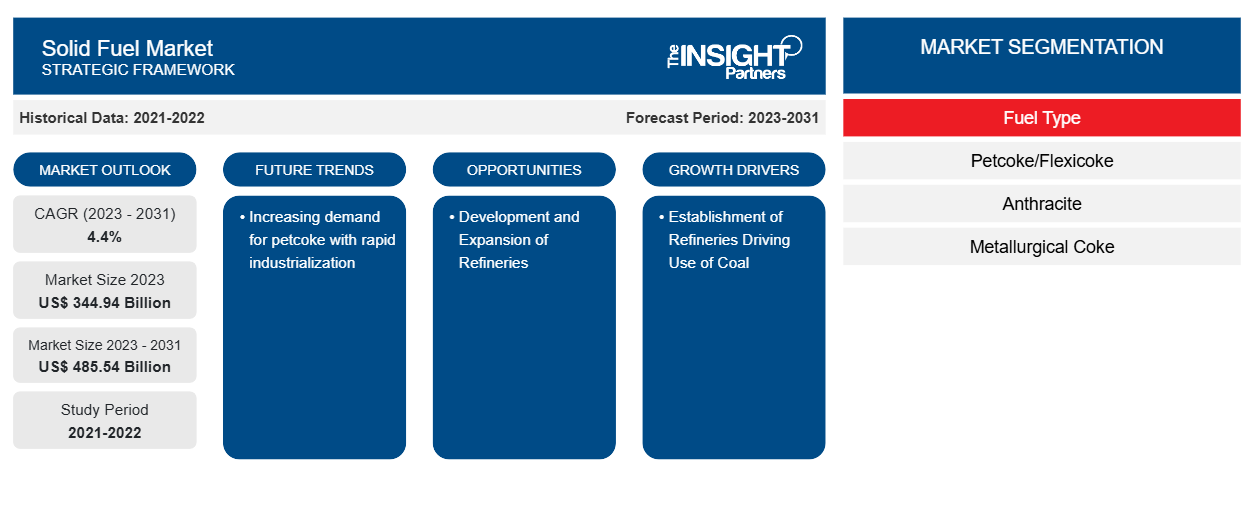Si prevede che la dimensione del mercato dei combustibili solidi raggiungerà i 485,54 miliardi di dollari entro il 2031, rispetto ai 344,94 miliardi di dollari del 2023. Si prevede che il mercato registrerà un CAGR del 4,4% nel periodo 2023-2031. Si prevede che la crescente domanda di pet coke con rapida industrializzazione rimarrà una tendenza chiave nel mercato.
Analisi del mercato dei combustibili solidi
Si prevede che l'uso del carbone in diversi settori industriali in tutto il mondo stimolerà la crescita del mercato durante il periodo di previsione. Inoltre, si prevede che un aumento nello sviluppo o nell'istituzione di raffinerie di petrolio e gas alimenterà ulteriormente la crescita del mercato dei combustibili solidi durante il periodo di tempo analizzato . Tuttavia, le normative governative volte a ridurre le emissioni di carbonio e la disponibilità di sostituti del carbone sono i principali fattori limitanti che ostacolano la crescita del mercato dei combustibili solidi nei prossimi anni. Inoltre, si prevede che lo sviluppo e l'espansione delle raffinerie e l'aumento della domanda di combustibili solidi guideranno la crescita del mercato dal 2023 al 2031.
Panoramica del mercato dei combustibili solidi
La crescente domanda di combustibile solido per la generazione di elettricità e dall'industria dei carburanti per i trasporti guida la crescita del mercato dei combustibili solidi. L'elettricità è utilizzata in un'ampia gamma di scopi domestici, commerciali e industriali. Nel corso degli anni, l'uso di elettricità è aumentato. Secondo i dati della US Energy Information Administration pubblicati nel 2023, il consumo totale di elettricità negli Stati Uniti è stato di 4,07 trilioni di kWh nel 2022, ovvero 14 volte maggiore rispetto al consumo di elettricità nel 1950. Pertanto, il crescente utilizzo di elettricità sta alimentando la crescita del mercato dei combustibili solidi.
L'acciaio è sempre più utilizzato in tutti i settori, in quanto è il materiale più importante per la produzione di componenti utilizzati in automobili, utensili, prodotti edili, frigoriferi, lavatrici e altri elettrodomestici. Inoltre, il pet coke viene utilizzato come materia prima per produrre acciaio. Durante la produzione dell'acciaio, viene prodotto un metcake . Pertanto, la crescente industria siderurgica spinge la domanda di getcoke e produce metcoke che può essere utilizzato nei processi dell'industria siderurgica , il che guida la crescita del mercato dei combustibili solidi.
Personalizza questo report in base alle tue esigenze
Riceverai la personalizzazione gratuita di qualsiasi report, comprese parti di questo report, o analisi a livello nazionale, pacchetto dati Excel, oltre a usufruire di grandi offerte e sconti per start-up e università
-
Scopri le principali tendenze di mercato in questo rapporto.Questo campione GRATUITO includerà analisi di dati che spaziano dalle tendenze di mercato alle stime e alle previsioni.
Driver e opportunità del mercato dei combustibili solidi
Creazione di raffinerie che favoriscono l'uso del carbone per favorire il mercato
Le raffinerie di petrolio nel mondo sono utilizzate per produrre una varietà di prodotti finali, tra cui benzina, anodi di carbonio, carburante per aviazione e olio combustibile. La crescente istituzione di raffinerie di petrolio nel mondo ha portato ad aumentare la domanda di carbone come risorsa energetica. Quattro delle dieci più grandi società di raffinazione del petrolio nel mondo si trovano in Asia, mentre tre si trovano in Nord America e altre società di raffinazione del petrolio si trovano in Europa. Stati Uniti, Cina, Russia e India hanno le maggiori capacità di raffinazione del petrolio al mondo. L'Asia Pacifica è un rifugio che ha il maggior numero di raffinerie di petrolio operative. C'erano circa 310 raffinerie di petrolio operative nella regione a partire dal 2021. A causa della crescente domanda da parte di potenze economiche come India e Cina, circa 90 impianti di raffinazione sono in una fase di pianificazione o in fase di lavorazione (costruzione).
Sviluppo ed espansione delle raffinerie
A giugno 2022, il rapporto sul mercato petrolifero dell'IEA prevedeva che la capacità di raffinazione globale netta si sarebbe espansa di altri 1,6 milioni di barili al giorno nel 2023. L'espansione o la nuova crescita della capacità di raffinazione consiste in vari progetti di raffinazione ad alta capacità in corso, soprattutto in Medio Oriente e in Cina. La regione sopra e il paese hanno il potenziale per aggiungere oltre 4,0 milioni di barili al giorno di nuova capacità nei prossimi due anni.
- In Cina, si prevede che la capacità complessiva avrà un effetto valanga a causa dell'avvio di almeno due nuovi progetti di raffinazione e di una grande espansione di una raffineria.
- Nel 2021 è stata ampliata una notevole capacità di raffinazione in Medio Oriente. In Arabia Saudita, la raffineria di Jizan con una capacità di 400.000 b/g è entrata in funzione entro la fine del 2021 e ha iniziato a esportare prodotti petroliferi all'inizio del 2022.
- Si stima che una nuova costruzione di raffinazione con una capacità di oltre 2 milioni di barili al giorno entrerà in funzione per assistere i mercati nel bacino dell'Oceano Indiano. Insieme a questo, è previsto un altro importante progetto nel bacino atlantico. Dopo il completamento del progetto menzionato, una raffineria Dangote Industries da 650.000 barili al giorno a Lagos (Nigeria) sarà la più grande del paese. Lo sviluppo di una raffineria soddisferebbe la domanda di petrolio nazionale e dei paesi africani limitrofi.
Pertanto, l'espansione delle raffinerie aumenterebbe l'uso di combustibili solidi, il che dovrebbe offrire opportunità redditizie per il mercato dei combustibili solidi durante il periodo di previsione.
Analisi della segmentazione del rapporto sul mercato dei combustibili solidi
Il segmento chiave che ha contribuito alla derivazione dell'analisi del mercato dei combustibili solidi è il tipo di combustibile.
- In base al tipo di combustibile, il mercato dei combustibili solidi è suddiviso in petcoke/flexicoke, antracite, coke metallurgico e carbone. Il segmento del carbone ha detenuto una quota di mercato maggiore nel 2023.
Analisi della quota di mercato dei combustibili solidi per area geografica
L'ambito geografico del rapporto sul mercato dei combustibili solidi è suddiviso principalmente in cinque regioni: Nord America, Asia Pacifico, Europa, Medio Oriente e Africa, Sud e Centro America.
L'Asia Pacifica è leader del mercato. In base al paese, il mercato dei combustibili solidi nell'Asia Pacifica è suddiviso in Australia, Cina, India, Giappone, Corea del Sud e resto dell'Asia Pacifica. L'Asia Pacifica ha la presenza di molti produttori di pet coke che hanno portato a guidare la crescita del mercato durante il periodo di tempo analizzato. La Cina è uno dei paesi di spicco nel mercato dei combustibili solidi nell'Asia Pacifica. La regione ha una forte produzione di carbone in quanto è una fonte essenziale per la produzione di energia che può aumentare la domanda di carbone nella regione che a sua volta dovrebbe alimentare la crescita del mercato dal 2023 al 2031. C'è un aumento della produzione di acciaio nella regione dell'Asia Pacifica. La World Steel Association ha dichiarato a dicembre 2022 che Asia e Oceania hanno prodotto 101,4 Mt di acciaio a novembre 2022, con un aumento del 2,7% rispetto a novembre 2021. Inoltre, secondo i dati del Ministero indiano dell'acciaio pubblicati a dicembre 2022, la produzione nazionale di acciaio è salita a 78,09 Mt nell'anno fiscale 2022 da 73,02 Mt nell'anno fiscale 2021, con un aumento del 6,9%. Poiché l'antracite viene utilizzata nel processo di fabbricazione dell'acciaio, l'aumento della produzione di acciaio stimolerà la domanda di antracite, che, a sua volta, dovrebbe rafforzare il mercato dei combustibili solidi nei prossimi anni.
Approfondimenti regionali sul mercato dei combustibili solidi
Le tendenze regionali e i fattori che influenzano il mercato dei combustibili solidi durante il periodo di previsione sono stati ampiamente spiegati dagli analisti di Insight Partners. Questa sezione discute anche i segmenti e la geografia del mercato dei combustibili solidi in Nord America, Europa, Asia Pacifico, Medio Oriente e Africa, e Sud e Centro America.

- Ottieni i dati specifici regionali per il mercato dei combustibili solidi
Ambito del rapporto sul mercato dei combustibili solidi
| Attributo del report | Dettagli |
|---|---|
| Dimensioni del mercato nel 2023 | 344,94 miliardi di dollari USA |
| Dimensioni del mercato entro il 2031 | 485,54 miliardi di dollari USA |
| CAGR globale (2023-2031) | 4,4% |
| Dati storici | 2021-2022 |
| Periodo di previsione | 2023-2031 |
| Segmenti coperti |
Per tipo di carburante
|
| Regioni e Paesi coperti |
America del Nord
|
| Leader di mercato e profili aziendali chiave |
|
Densità degli attori del mercato: comprendere il suo impatto sulle dinamiche aziendali
Il mercato del Solid Fuel Market sta crescendo rapidamente, spinto dalla crescente domanda degli utenti finali dovuta a fattori quali l'evoluzione delle preferenze dei consumatori, i progressi tecnologici e una maggiore consapevolezza dei benefici del prodotto. Con l'aumento della domanda, le aziende stanno ampliando le loro offerte, innovando per soddisfare le esigenze dei consumatori e capitalizzando sulle tendenze emergenti, il che alimenta ulteriormente la crescita del mercato.
La densità degli operatori di mercato si riferisce alla distribuzione di aziende o società che operano in un particolare mercato o settore. Indica quanti concorrenti (operatori di mercato) sono presenti in un dato spazio di mercato in relazione alle sue dimensioni o al valore di mercato totale.
Le principali aziende che operano nel mercato dei combustibili solidi sono:
- Società petrolifera indiana Ltd.
- Elinoil Hellenic Petroleum Company SA
- RESORBENT Sro
- Azienda JH CARBON PTY LTD
- Società Chevron
- Azienda Phillips 66
Disclaimer : le aziende elencate sopra non sono classificate secondo un ordine particolare.

- Ottieni una panoramica dei principali attori del mercato dei combustibili solidi
Notizie e sviluppi recenti sul mercato dei combustibili solidi
Il mercato dei combustibili solidi viene valutato raccogliendo dati qualitativi e quantitativi dopo la ricerca primaria e secondaria, che include importanti pubblicazioni aziendali, dati associativi e database. Di seguito sono elencati alcuni degli sviluppi nel mercato dei combustibili solidi:
- Petróleos de Venezuela, SA (PDVSA) ha firmato due contratti con Latif Petrol e Reussi Trading. Attraverso questi accordi, PDVSA esporterà ~ 1,6 milioni di tonnellate metriche di pet coke. (Fonte: PDVSA, comunicato stampa, luglio 2023)
- SOCAR Star Oil Refinery ha aumentato la produzione di pet coke del 23,7% nell'ottobre 2023. Ciò ha ampliato la capacità produttiva della raffineria nel mercato del pet coke. (Fonte: SOCAR Star Oil Refinery, comunicato stampa, dicembre 2023)
Copertura e risultati del rapporto sul mercato dei combustibili solidi
Il rapporto “Dimensioni e previsioni del mercato dei combustibili solidi (2021-2031)” fornisce un’analisi di mercato dettagliata che copre le seguenti aree:
- Dimensioni e previsioni del mercato dei combustibili solidi a livello globale, regionale e nazionale per tutti i segmenti di mercato chiave coperti dall'ambito
- Tendenze del mercato dei combustibili solidi, nonché dinamiche di mercato quali fattori trainanti, vincoli e opportunità chiave
- Analisi PEST e SWOT dettagliate
- Analisi del mercato dei combustibili solidi che copre le principali tendenze del mercato, il quadro globale e regionale, i principali attori, le normative e i recenti sviluppi del mercato
- Analisi del panorama industriale e della concorrenza che copre la concentrazione del mercato, l'analisi della mappa di calore, i principali attori e gli sviluppi recenti per il mercato dei combustibili solidi
- Profili aziendali dettagliati
- Analisi storica (2 anni), anno base, previsione (7 anni) con CAGR
- Analisi PEST e SWOT
- Valore/volume delle dimensioni del mercato - Globale, Regionale, Nazionale
- Industria e panorama competitivo
- Set di dati Excel
Report recenti
Testimonianze
Motivo dell'acquisto
- Processo decisionale informato
- Comprensione delle dinamiche di mercato
- Analisi competitiva
- Analisi dei clienti
- Previsioni di mercato
- Mitigazione del rischio
- Pianificazione strategica
- Giustificazione degli investimenti
- Identificazione dei mercati emergenti
- Miglioramento delle strategie di marketing
- Aumento dell'efficienza operativa
- Allineamento alle tendenze normative























 Ottieni un campione gratuito per - Mercato dei combustibili solidi
Ottieni un campione gratuito per - Mercato dei combustibili solidi